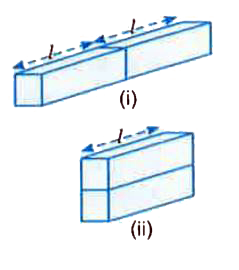Two similar planoconvex lenses are combined together in three different ways as shown in the adjoining figure. The ratio of the focal lengths in three cases will be

2:2:1
1:1:1
1:2:2
2:1:1
The correct Answer is:B
In each case two plane− convex lens are placed close to each other, and 1F=1f1+1f2
Topper's Solved these Questions
- GEOMETRICAL OPTICSBook:A2ZChapter:GEOMETRICAL OPTICSExercise:Prism Theory And Dispersion Of Light
Explore 45 Videos
- GEOMETRICAL OPTICSBook:A2ZChapter:GEOMETRICAL OPTICSExercise:Optical Instruments
Explore 55 Videos
- GEOMETRICAL OPTICSBook:A2ZChapter:GEOMETRICAL OPTICSExercise:Section D - Chapter End Test
Explore 30 Videos
- ELECTROMAGNETIC WAVES AND COMMUNICATION SYSTEM Book:A2ZChapter:ELECTROMAGNETIC WAVES AND COMMUNICATION SYSTEM Exercise:Section D - Chapter End Test
Explore 30 Videos
- MAGNETISM AND MATTERBook:A2ZChapter:MAGNETISM AND MATTERExercise:Section D - Chapter End Test
Explore 30 Videos
Similar Questions
Two identical slabs of given metal are joined together in two different ways as shown in figure. What is the ratio of the resistance of these two combinations?

View SolutionTwo identical slabs, of a given metal, are joined together, in two different ways, as shown in Fig.(i) and (ii). What is the ratio of the resistances of these two combinations ?

View Solution
Knowledge Check
Two similar p−n junctions can be connected in three different ways as shown in the figure. The two connections across which the potentional difference is same are.
(a) Acircuit a and bBcircuit b and cCcircuits a and cDall the circuits
Acircuit a and bBcircuit b and cCcircuits a and cDall the circuitsTwo identical thin planoconvex lenses of refractive index n are silvered, one on the plane side and other on the convex side. The ratio of their for lengths is
An/(n−1)B(n−1)/nC(n+1)/nDnThree cubes each of edge 3 cm long are placed together as shown in the adjoining figure . Find the surface area of the cuboid so formed :
 A182 sq. cmB162 sq. cmC126 sq. cmDnone of these
A182 sq. cmB162 sq. cmC126 sq. cmDnone of these
Two identical springs (springs constant K) are connected together in three different ways. In which case will the spring factor of the oscillation of the body be least ?

View SolutionTwo plano-convex lenses of focal lengths 20cm and 30cm are placed together to form a double convex lens. The final focal length will be
View SolutionWhen two thin lenses are kept in contanct, the focal length of the combination is
View SolutionThree charges of (+2q),(−q) and (−q) are placed at the corners A,B and C of an equilateral triangle of side a as shown in the adjoining figure. Then the dipole moment of this combination is

View SolutionTwo thin convex lenses of focal lengths 4 cm and 8 cm are
separated by a distance of 4 cm in air. The combination will
have the focal length
View Solution

